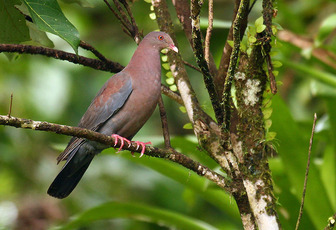The Red-billed Pigeon, Patagioenas flavirostris , is a relatively large pigeon which breeds from southern Texas, United States, and northwestern Mexico south to Costa Rica. It belongs to a clade of Patagioenas which generally lack iridescent display plumage, except some vestiges in the Pale-vented Pigeon.

The Red-billed pigeon is classified as Least Concern. Does not qualify for a more at risk category. Widespread and abundant taxa are included in this category.
The Red-billed Pigeon, Patagioenas flavirostris (see Johnson et al. 2001), is a relatively large pigeon which breeds from southern Texas, United States, and northwestern Mexico south to Costa Rica. It belongs to a clade of Patagioenas which generally lack iridescent display plumage, except some vestiges in the Pale-vented Pigeon. It is found in open country with some trees, large clearings and cultivation in lowlands and middle altitudes to 2100 meters.
The Red-billed Pigeon has a large range, estimated globally at 830,000 square kilometers. Native to the United States and Mexico as well as Belize, Costa Rica, El Salvador, Guatemala, Honduras, and Nicaragua, this bird prefers neritic, oceanic, and coastal marine ecosystems. The global population of this bird is estimated at 500,000 to 5,000,000 individuals and does not show signs of decline that would necessitate inclusion on the IUCN Red List.
Red-billed Pigeons in a palm tree in Alajuela, Costa Rica. We first heard their “Cooc cu cu coooo!” calls coming from the palm tree and then easily spotted these large, conspicuous pigeons. Red-billed Pigeon (Patagioenas flavirostris) Adult Red-billed Pigeons have a dull, reddish purple head, breast, and shoulders, a slate gray belly, rump, tail, and wings, magenta legs, orange eyes with a red eye-ring, and a distinctive yellowish white bill with a pinkish red base and cere.
Red-billed Pigeon: Breeds from south Sonora, Mexico south in lowlands along the Pacific slope to Chiapas, and the lower Rio Grande Valley of south Texas and Mexico from eastern Nuevo Leon and Tamaulipas, south along the Atlantic slope to the Yucatan states. Populations of northeastern Mexico and Texas move south during non-breeding season. Preferred habitat includes tropical deciduous forests.
Pigeon Patrol Products & Services is the leading manufacturer and distributor of bird deterrent (control) products in Canada. Pigeon Patrol products have solved pest bird problems in industrial, commercial, and residential settings since 2000, by using safe and humane bird deterrents with only bird and animal friendly solutions. At Pigeon Patrol, we manufacture and offer a variety of bird deterrents, ranging from Ultra-flex Bird Spikes with UV protection, Bird Netting, 4-S Bird Gel and the best Ultrasonic and audible sound devices on the market today.
Voted Best Canadian wholesaler for Bird Deterrent products ten years in a row.
Contact us at 1- 877– 4– NO-BIRD, (604) 585-9279 or visit our website at www.pigeonpatrol.ca
Pigeon/Pigeon Patrol / Pigeons Roosting / Vancouver Pigeon Control /Bird Spikes / Bird Control / Bird Deterrent / Pigeon Deterrent? Surrey Pigeon Control / Pest /Seagull deterrent / Vancouver Pigeon Blog / Birds Inside Home / Pigeons in the cities / Ice Pigeons/ What to do about pigeons/ sparrows , Damage by Sparrows, How To Keep Raccoons Away, Why Are Raccoons Considered Pests/ De-fence / Pigeon Nesting/ Bird Droppings / Pigeon Dropping/ woodpecker control/ Professional Bird Control Company/ Keep The Birds Away/ Birds/rats/ seagull/pigeon/woodpecker/ dove/sparrow/pidgeon control/pidgeon problem/ pidgeon control/flying rats/ pigeon Problems/ bird netting/bird gel/bird spray/bird nails/ bird guard

